In today’s world of modern convenience, it’s easy to overlook the humble beginnings of everyday appliances that have been with us for generations. The toaster, a simple yet revolutionary device, holds a special place in the history of kitchen innovation. It has evolved from a basic tool of the early 20th century into an indispensable part of our daily routines.
The Spark of Innovation
The earliest form of the toaster dates back to ancient times when people toasted bread over an open flame. This method was the norm until 1905, when a young Albert Marsh, deemed the “father of the electrical toaster,” revolutionized bread toasting. Marsh, a talented engineer, invented the first electric toaster called the “Eclipse.” This rudimentary device was quite simple, consisting of iron wiring and a steel frame. Although inefficient, it set the stage for future developments.
The Golden Age of Toasters
The 1920s to 1950s is often considered the Golden Age of Toasters, a period when art and functionality merged. This era saw the advent of the pop-up toaster, which allowed bread to be ejected without manual intervention. The period’s hallmark was the incorporation of beautiful designs, inspired by Art Deco and Streamline Moderne, with sleek lines, chrome finishes, and minimalistic features.
One iconic model from this period is the Toastmaster, introduced by Waters Genter Company in 1926. The Toastmaster could brown bread on both sides simultaneously, reducing the manual effort required and ensuring evenly toasted bread. Its success laid the groundwork for toasters becoming staple items in American households.
The 1930s witnessed the emergence of toaster timers, temperature controls, and the automatic pop-up feature, innovations that propelled the appliance into the mainstream. These were not just tools but conversation pieces, often flaunting ornate designs, bright colors, and even lights to indicate when the toast was ready.
#1 Toaster with an Edison screw fitting, 1909.
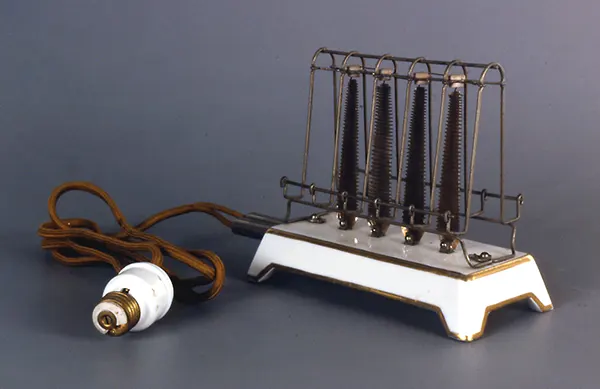
This unique toaster design allowed for direct power access via light sockets, a common electrical source then, reflecting the era's inventive spirit in adapting available technology for new conveniences. Made predominantly from materials like iron, these toasters were basic, with exposed heating elements that required vigilant manual monitoring to prevent the bread from burning, showcasing the nascent stage of home appliance development.
Despite their simplicity and the absence of features standard in today's models—like timers and automatic shut-off—these toasters marked a significant turning point in domestic life. They symbolized the dawn of electric appliances in households, paving the way for the modern, multi-functional devices we enjoy today.
#2 General Electric Model D-12 toaster, from 1910s.
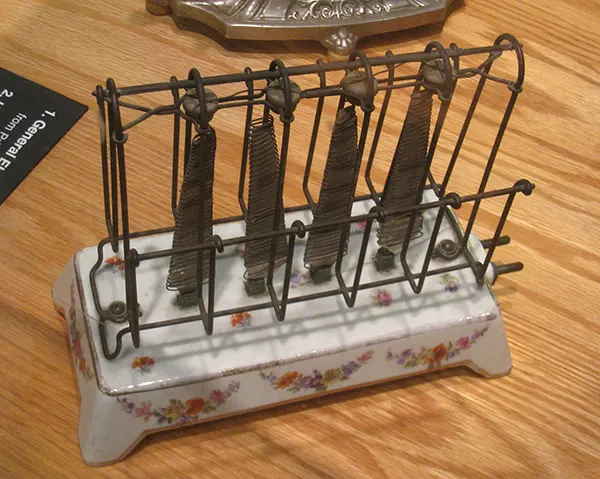
Crafted with a robust and stylish aesthetic, the Model D-12 broke away from the simplistic, utilitarian design of its predecessors. It featured a sleek, ornate exterior, often with decorative elements that mirrored the Art Deco style, making it not just a kitchen appliance but also a piece of art. The toaster was typically constructed of durable materials like chrome or nickel-plated steel, ensuring a lustrous finish that was highly resistant to rust and appealing to the contemporary consumer.
Functionally, the D-12 was innovative for its time, though it still required manual operation. Unlike modern toasters, it didn't have an automatic pop-up mechanism; instead, users had to manually turn the bread to ensure even toasting. This model was one of the first to incorporate a heating element that was protected by a cage, representing a significant step forward in user safety.
The D-12's design also included a clever door-like feature, where bread was placed between the heating elements and the user had to flip the doors to toast both sides. This was an early exploration into optimizing heat distribution for a more uniform toasting process, a feature that would evolve significantly in later models.
#3 The Turnover, 1920s.
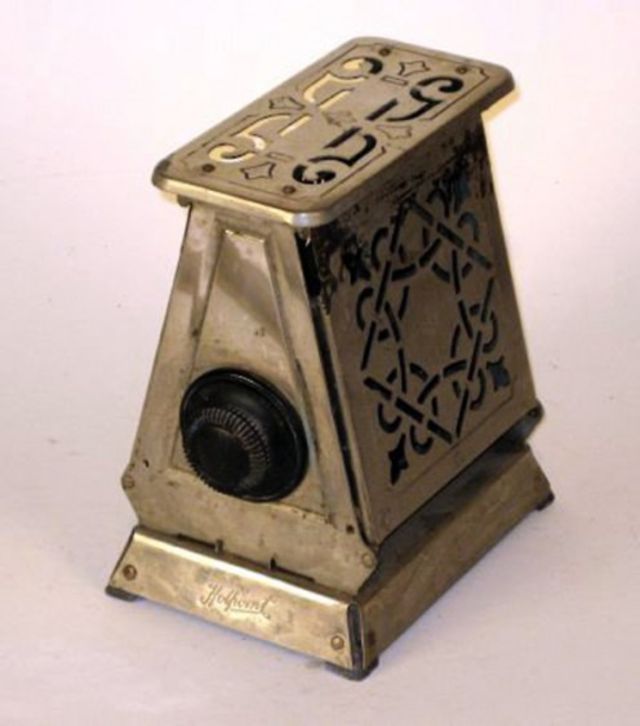
Turnover toaster offered a novel solution to one of toast-making's most tedious aspects: the need to manually flip the bread for even toasting on both sides. It was designed with convenience in mind, as it introduced a mechanism that allowed the bread to be flipped without the need to touch it, reducing the risk of burns or having the bread fall apart. This was achieved through a cleverly designed bread holder that could be reversed with a simple turn of a handle or push of a lever. This holder was typically a wire cage or a metal frame that securely cradled the bread slice, ensuring it remained intact during the flipping process.
In terms of design, the Turnover reflected the 1920s' characteristic style. It often featured a polished chrome exterior and an Art Deco influence, making it not just a practical appliance but also a stylish accessory for the kitchen. The toaster's aesthetics, combined with its innovative functionality, made it a popular household item, reflecting the era's affinity for elegance and mechanized convenience. The toaster's design catered to a growing middle class that sought appliances combining practicality with a touch of luxury, indicating the evolving consumer culture.
#4 The Flopper.
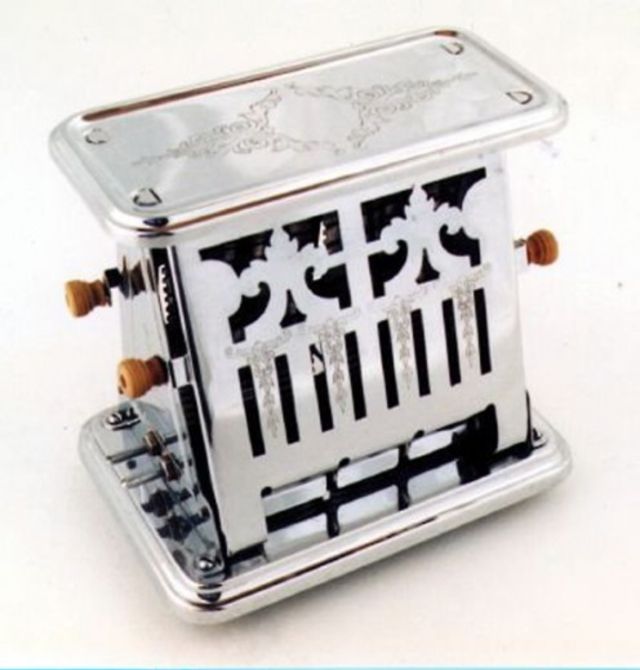
The key characteristic of The Flopper was its pair of metal doors with decorative cutout patterns, which served both functional and aesthetic purposes. These doors, hinged at the bottom, created what could be described as an "A" shape enclosure for slices of bread. This structure wasn't just for show; it played a crucial role in the toaster's signature mechanism.
Unlike modern toasters with spring-loaded trays, The Flopper required the user to open these side doors manually once the toasting was complete. Upon opening, the finished toast would "flop" forward out of the toaster - a simple yet effective solution to retrieve the toast without the risk of poking around near the heating elements or dealing with mechanisms that might jam or break. This gravity-assisted method was an ingenious way to safely and conveniently access the toasted bread, making the process seem somewhat theatrical and enjoyable.
#5 The Swinger.
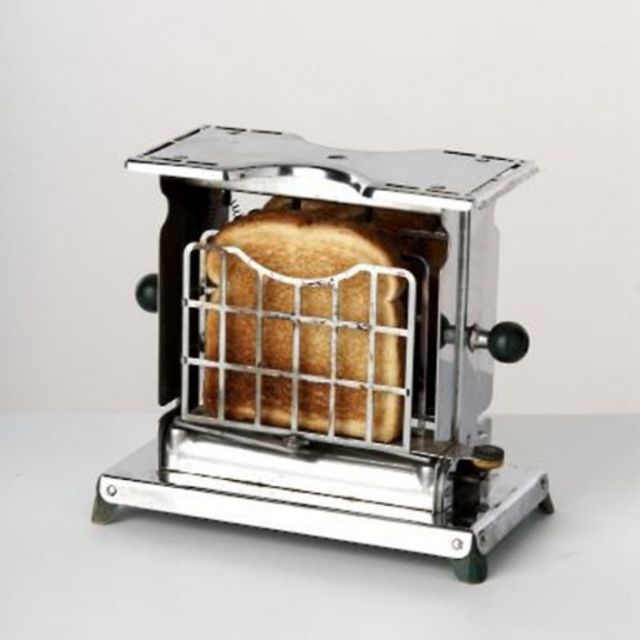
Known for its innovative design, the Swinger incorporated several features that set it apart from its contemporaries. entral to the Swinger's design was a distinctive swinging basket mechanism. This feature included a two-sided metal wire enclosure that held the bread slices securely. The real innovation came with the user's ability to flip the bread with a simple turn of a knob or handle, ensuring an even toasting on both sides without the need for manual flipping or risk of burns. This convenience was a significant selling point at a time when household chores were often labor-intensive.
It also offered an aesthetic touch by branding the toast with various distinctive patterns, from simple geometric designs to elaborate symbols. This added an element of whimsy and elegance to the breakfast routine, making the toast not just a food item but a conversation piece. The most groundbreaking aspect was when the Swinger design was adopted for the first four-slice toaster. This adaptation marked a shift toward recognizing the busy nature of domestic life and the need for efficiency in the kitchen. However, this novel appliance came with a high cost, reflecting the intricate design and the luxury of having multiple slices toasted simultaneously.
#6 The Sweetheart.
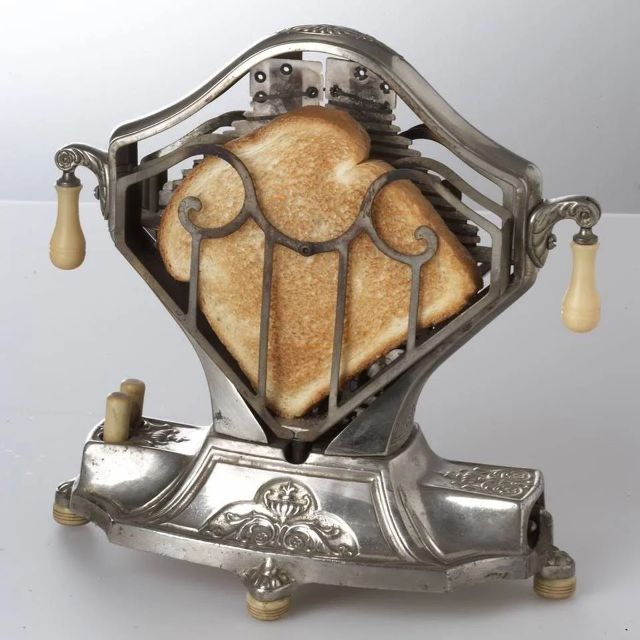
What made the Sweetheart particularly innovative was its mechanical sophistication in an age where most kitchen appliances were quite basic. The toaster featured a pair of buttons at its base, each one controlling a basket that held the bread. These baskets, when the buttons were pressed, swung out at a 90-degree angle. This feature was a notable advancement for safety and convenience, as it allowed for easy insertion and removal of bread slices, minimizing the risk of accidental burns from trying to retrieve toast from a hot surface.
The real ingenuity of the Sweetheart, however, lay in its flipping mechanism. After placing the bread in the basket and releasing the buttons, the baskets would return to their original position. A subsequent press would activate a rotation mechanism, turning the bread slices in the opposite direction without having to touch the potentially hot bread. This ensured an even toasting, a convenience that modern users often take for granted but was a novel luxury at the time.
#7 The Pop-Up, 1920s-1930s.
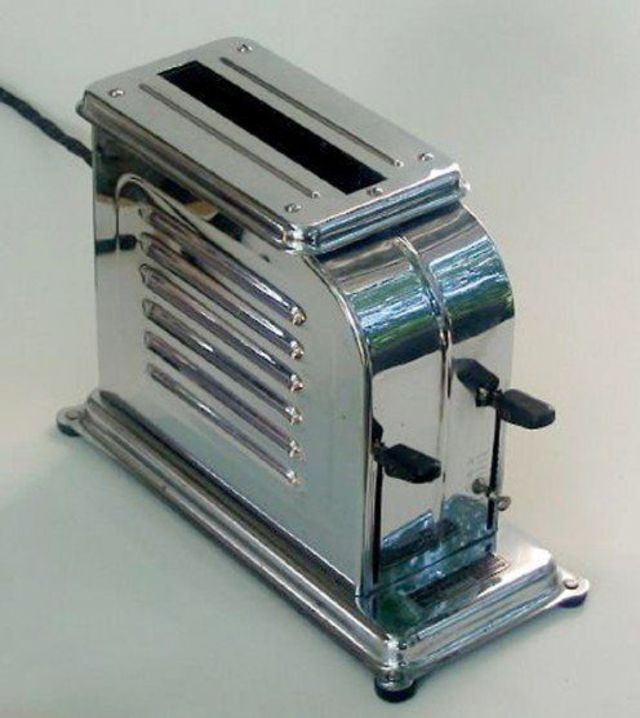
The defining feature of the pop-up toaster was its automatic functionality. Unlike its predecessors, this toaster used a clock mechanism to time the toasting process, a pioneering concept in home appliances. This innovation meant that, for the first time, users could insert their bread, set a desired time, and attend to other tasks, confident that the toaster would automatically pop up the toast once it reached the perfect level of brownness. This was a departure from earlier models, which required vigilant monitoring and manual flipping of the bread.
Equally important was Toastmaster's design, which included heating elements on both sides of the bread slots. This ensured an even distribution of heat and consistent toasting, qualities that modern consumers might take for granted but were cutting-edge at the time.
Before the advent of the pop-up model, automatic toasters were largely confined to restaurant use, seen as too luxurious for the average household. Toastmaster's introduction of the domestic pop-up toaster marked a shift, highlighting growing consumer interest in automated home conveniences. However, due to cost factors and entrenched cooking habits, many manufacturers continued producing manual models, and widespread adoption of automatic toasters didn't occur until the 1950s.


